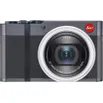what is fps in camera
The word "fps" stands for frames per second. If you are shooting video with a camera, this helps indicate the speed at which your camera can record footage.
Image source: https://paytmmall.com/
Recording higher fps speeds can make video much smoother to watch and minimizes the "jerkiness" or stuttering in video playback.
Image source: https://www.tatacliq.com/
You may have seen these other terms like 30p and 60i being used to describe recordings. Those just refer to whether the recording is 30 frames per second (30p) or 60 interlaced frames per second (60i).
Image source: https://www.smartprix.com/
To some people, this seems confusing as it may appear as though these two options are identical, yet they actually mean different things. In this article, we will briefly look at fps and explain the differences between each.
1 camera settings topic
Image source: https://www.flipkart.com/
When recording video from a camera, many people like to record at 30 or 60 fps. Sadly, there is little correlation between what frame rate your camera records and how smooth your footage will be.
Image source: https://gadgets360.com/
Even in 4K and even in HD, you are unlikely to see a difference between 30p (30 frames per second) or 60p (60fps) and slower frame rates such as 15p (15fps) or 8p (8fps).
Image source: https://www.snapdeal.com/
The reason for this is that frame rate simply refers to how many individual pictures are recorded for each second of footage. Increased frame rates do not expand the field of view or capture a more complete picture.
Image source: https://www.pinterest.com/
The only difference between 30p and 60p is that 30p is recorded at 24 frames per second while 60p is recorded at twice that. A video frame is essentially a snapshot at a particular position on the sensor,
Image source: https://www.reliancedigital.in/
so recording twice as many pictures per second allows you to create smoother footage by reducing the blurriness of each individual picture.
Image source: https://rtings.in/
While almost all professional videography tends to use either 24 or 25 fps, many consumers prefer 60 or 120 fps for its perceived smoothness.
Image source: https://www.amazon.com/
Many consumer cameras even record multiple frames to help improve image quality, although there is little evidence to suggest this makes any significant difference in real world use.
Real world fps
Image source: https://www.istockphoto.com/
While recording videos with a camera, it is important to remember that higher fps speeds mean less resolution. So, you will get a lower picture quality in fast paced action scenes.
Image source: https://www.shopclues.com/
This is because when your camera is recording at 60 or 120 fps, there are more pictures being taken at the same time than if you were only capturing 24 images per second. The result of this is choppy video footage which will be very difficult to edit and even impossible in some cases.
Image source: https://www.smartprix.com/
This is why if you are only interested in creating simple home movies it may be best to stick with the lower frame rates of 30p and 60i despite their increased resolution.
What is fps in camera? [End of article
By: X-Pro2, X-T2, X100F, F-1.
Thanks to: Sebastien, Balthazar, mr_piggy, lechwacki1, John.
Image source: https://www.istockphoto.com/
ARTICLE BACKGROUND INFORMATION [to use as knowledge, not to be copied verbatim]:what is fps in camera [to use as knowledge not to be copied verbatim]
1) What are the common frame rates of video and why are they used? [Editorial selection of answers]
2) How important is the common frame rate of video?
3) Are there any other ways to calculate what fps is faster or slower than another? (e.g. 60fps/30fps/120fps etc.
Image source: https://www.shopclues.com/














Comments
Post a Comment